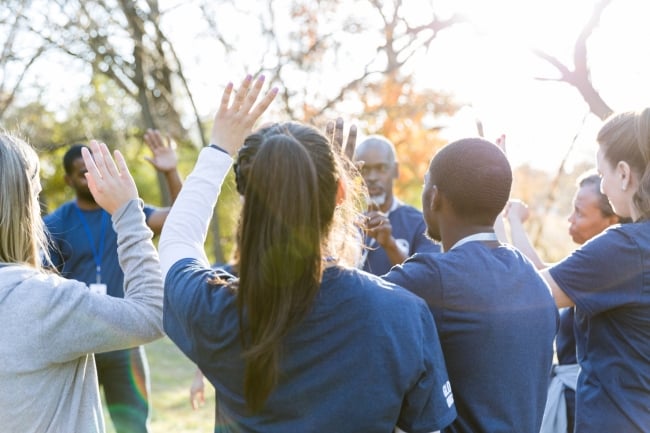You have /5 articles left.
Sign up for a free account or log in.

Nearly a third of students spend no time weekly on extracurriculars, and the void is bigger for certain groups, according to the newest Student Voice survey. The good news? Experts say closing these gaps—in the interest of student success—is a matter of getting students meaningfully involved in just one or two activities.
SDI Productions/E+/Getty Images
Student engagement in the classroom is correlated with a variety of student success metrics. But even involvement in campus life beyond the classroom is linked to increased academic achievement, retention, belonging and interest from potential employers. So it’s concerning that Student Voice data reveal disparities in who is getting involved in campus life, and how much.
The most recent Student Voice survey, circulated this summer by Inside Higher Ed and College Pulse, asked 3,000 two- and four-year college students about their college experience, including their participation in extracurricular activities and campus events. Half of respondents spend one to five hours per week on extracurriculars, clubs and groups associated with their institutions. Just 14 percent spend six to 10 hours, and 7 percent spend more than 10 hours on these activities (think student government, campus newspaper, club sports and more).
And nearly one-third of students spend no time weekly on extracurriculars.
That’s over all. Looking at the findings by institution type, more than half of two-year college students spend zero hours per week on these activities, compared to a quarter of four-year college students. Students at public institutions are also much more likely than their private nonprofit college counterparts to spend no time on extracurriculars, at 36 percent versus 14 percent, respectively.
First-generation college students spend less time on extracurriculars than their continuing-generation peers, as well, with 37 percent of the former group logging zero hours per week versus 25 percent of the latter. And about half of students working 30 or more hours weekly spend no time on extracurriculars, versus about a quarter of their peers who work part-time or not at all.
Additional differences:
- Nearly a third of students with financial aid (31 percent) spend zero hours per week on extracurriculars, versus a quarter (25 percent) of students with no financial aid.
- A third of women say they spend no time on extracurriculars, versus a quarter of men and a fifth of nonbinary students.
- By race, 40 percent of Hispanic students say they spend zero hours weekly on extracurricular activities, compared to 29 percent each of white and Black students and 16 percent of Asian students.
These experience gaps likely stem from larger socioeconomic factors. Hispanic respondents to the survey are likelier than students from other racial groups to say they work full-time (32 percent versus 22 percent for the group as a whole), for example, so it makes sense that these students would have less time to get involved in campus life.
Whatever drives these numbers, they pose important questions about equity and student success.
“If we look at the students who are not engaged, there’s obviously a relationship between income status and also racial or ethnic identity,” says Kevin Kruger, president of NASPA, Student Affairs Administrators in Higher Education. “The challenge for higher ed—just as in other aspects of the student success agenda—is we need to look at what kinds of experiences students are having that are not resulting in academic progress and completion.”
Solving the Participation Puzzle
If off-campus employment limits students’ ability to get involved on campus, for example, Kruger says, institutions can promote on-campus work opportunities (and some do). To his point, and in another set of findings from the recent Student Voice survey, relatively more students (36 percent) cite off-campus work as a barrier to participation in campus extracurricular activities and events than on-campus work (30 percent).
What else limits students’ involvement in campus life? Timing and location of events is respondents’ top reported barrier to participation, with 41 percent saying this. Lack of knowledge about activities or events is another major hurdle, with 31 percent of students selecting this.
Other less common reasons for not getting involved (from a list of 11 options):
- Costs of participation (20 percent)
- Not living near campus (19 percent)
- Feeling like I don’t belong (18 percent)
- Care-taking responsibilities (15 percent)
- Mental health conditions (14 percent)
- Physical health conditions (6 percent)
Equity factors in here, too, with students receiving financial aid (n=2,181) being significantly more likely than their peers without financial aid (n=734) to cite various barriers to participation. Timing and location of events is a hurdle for 43 percent of students receiving financial aid versus 31 percent of students not on financial aid. Regarding off-campus work, 38 percent of students on financial aid say it’s a barrier to participation in campus life, compared to 29 percent of students not receiving financial aid.
Zayd Hamid, a first-gen undergraduate at George Mason University in Virginia enrolled in an accelerated master’s degree program in public policy, is at the high end of the involvement scale, spending about 10 hours a week on student government. Hamid, an aspiring university president, also serves on a student advisory board to his university’s president and works part-time as a manager and brand ambassador for campus recreation. He previously worked as a new-student orientation leader and resident adviser.
Hamid says he manages these and other responsibilities and interests by “living very much in accordance with my Outlook calendar” and by using Fridays and weekends to get ahead on the next week’s workload.
“The balance is being able to be in the moment and focus on tasks that need to get done,” he says. “I’m getting better, but it is a struggle for me at times. There’s no sugarcoating that.”
Hamid agrees that it helps to work on campus versus off, as he feels involved in university life even when he’s on duty.
“Personally speaking, I feel that campus work is not a barrier to campus life—it’s a way to get involved in it,” he says, qualifying that he’s consistently worked for university life programs relevant to the student experience. “If a campus has a vibrant work culture across units, that directly contributes to students feeling involved in campus life and work. And if we incorporate feelings of belonging, well-being and engagement into the workplace culture across campus units, which I think George Mason University does very well, that helps students feel like they belong.”
Braque Talley, vice president of student affairs at Alabama A&M University, a historically Black institution, says his administration, for some of these reasons, recently raised the campus minimum wage to $12 from the federal minimum ($7.25) to promote on-campus student employment. He also argues for expanding the definition of involvement to include activities like working out with others at the campus gym. And he emphasizes the importance of classroom engagement in promoting not only student success but outside-of-class involvement and belonging.
“They go hand in hand with each other,” Talley says of classroom engagement and campus involvement.
Other pieces of the puzzle: meeting students where they are and creating incentives for students to participate. Alabama A&M brings activities to students’ residence halls. Two recent examples include a cooking tournament and a barbershop pop-up. The university also held a dance for students who missed out on their high school proms due to COVID-19, explains Talley.
Alabama A&M offers incentives for attending large-scale events. Students who check in on a platform called Presence receive points (one point for attending an athletic event and, say, four points for attending a Nobel laureate’s talk). These points make students eligible for regular drawings for cash or scholarships—some $500 this month alone—and even larger end-of-semester prizes. The university also solicits feedback from students about event quality via the platform.
“This may sound a bit pricey, but it’s not, because more students are getting engaged,” Talley says. “And the more students are engaged, the higher our retention rate and ultimately that graduation rate will be. We’re not forcing them. But we’re putting some dessert on top of the broccoli so that they can be excited about their engagement levels.”
The Student Voice survey asked respondents what would increase their involvement in extracurriculars at their institutions. The top factor? Better advertising and promotion, with nearly half of students saying this. That’s followed by less academic pressure and work, meeting times and days that fit better with one’s schedule, knowing someone to make introductions, and social media presence of specific groups.
The option to meet virtually is not a popular choice (of 15 possible choices), with just 14 percent of students selecting it, suggesting that students are eager for face-to-face experiences in this area of their lives. This makes more sense when considering that 70 percent of students say the top benefit of participating in clubs, groups and other extracurriculars is meeting new people and making new friends.
Distant second reasons for getting involved are sense of belonging or connectedness to campus life and activism or being involved in one’s community (both 28 percent). Passion and practicality are even lower down the list, with smaller shares of students saying they get involved to do something they love, gain professional experience and have activities to put on their résumés. This hierarchy of benefits is relatively consistent across student groups and institution types, with even 62 percent of students who take all their classes online saying they do extracurriculars to meet people and make new friends.
Thriving, Face-to-Face
Kruger, of NASPA, says that Gen Z (or today’s traditional-age college students, who make up the majority of Student Voice respondents), is a “very transactional, instrumental generation,” in that they’re concerned about college costs and “want what they do in college to connect to their career.” Yet at the same time, he says, Gen Z is grappling with the “negative impacts of social media on mental health and a variety of other factors, including correlations to loneliness.”
In this light, face-to-face campus involvement is a “small antidote to the social media crisis of this generation.”
Laurie Schreiner, professor of higher education at Azusa Pacific University and a scholar of student thriving, says that while other elements of the student experience are more predictive of student thriving than campus involvement, it’s nonetheless a significant predictor. Moreover, she says, social connectedness is definitional to thriving—and students need that connectedness more than ever.
“COVID has just destroyed the social skills of students. They know how to connect through social media, but they’re not so great when they are in person with others. And yet they desperately want those relationships.”
As for what would boost their participation in campus events—which was a distinct category from extracurriculars and defined as guest speakers, sporting events, workshops and the like—nearly half of Student Voice respondents again cite better advertising and promotion. About one in three students cites each of the following: times and days that better fit their schedules, less academic pressure and coursework, and more work-life balance on campus.
Nearly one in four students says they’d be motivated to attend more campus events by some kind of academic credit or credential, such as a badge, extra credit or satisfying a general education requirement.
Virtual participation options are more popular for events (20 percent say this would boost their participation) than for extracurriculars, but they’re still far down the student priority list. Perhaps surprisingly, students at four-year institutions are more likely than their two-year college counterparts to say times and days that fit their schedules would boost their campus event participation, at 33 percent versus 24 percent, respectively. Four-year students are also more likely to cite less academic pressure and work.
How can institutions better promote extracurriculars and campus events? Talley says student ambassadors on his campus play a key role in getting the word out via sponsored social media posts. George Mason has a campus events platform called Mason 360, but Hamid advocates a “hybrid” approach, in which students advertise online as well as in person, including at campus activities fairs and even old-school chalking campaigns.
Involvement: Quality Over Quantity
However institutions catch their students’ attention, how much campus involvement is enough, or too much? And returning to related questions of equity, how much time do relatively underinvolved students need to invest in campus life to reap benefits? Schreiner and her colleagues have found that it’s very much a matter of quality over quantity: sustained involvement in just one or two meaningful activities directly predicts thriving.
“That can be good news to say to students, ‘Get involved with fewer things but more deeply, and you’re going to then have the kind of friendship connections and opportunities and quality of relationships that you’re really looking for,’” she says.
Hamid, a senior, says that’s certainly true to his experience.
“A lot of freshmen will come into the university thinking, ‘I’m gonna join every single club.’ And you can’t join every club. There’s only 24 hours in a day. So it’s really about figuring out, ‘How do we get people to commit and stay engaged so they can build their community?’ Because the community exists and a lot of students do take advantage of it. I genuinely believe we have thriving campus engagement—we just need students who aren’t already engaged to join the party.”
How is your campus promoting student involvement in campus life outside the classroom? Tell us.




